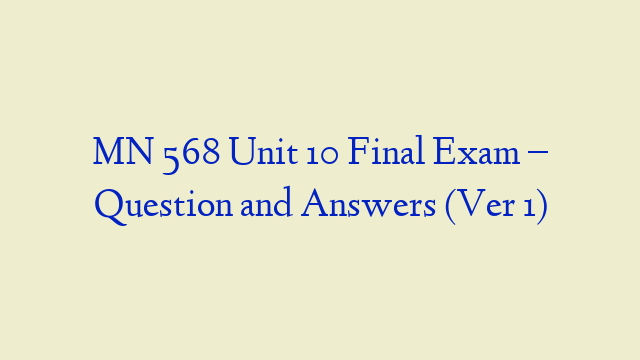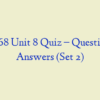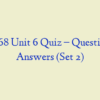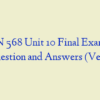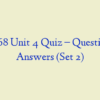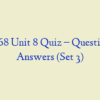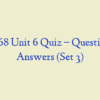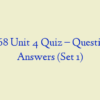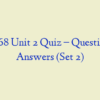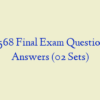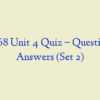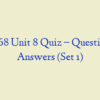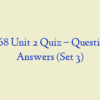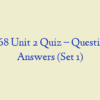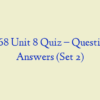Description
MN 568 Unit 10 Final Exam – Question and Answers
- Which statement about confusion is true?
- Sondra’s peripheral vestibular disease causes dizziness and vertigo. Which of the following medications will help to decrease edema in the labyrinth of the ear?
- The hallmark of an absence seizure is:
- How often should drug levels be monitored when a seizure medication has controlled the seizures, and the drug level is adequate?
- Which of the following persons fits the classic description of a patient with multiple sclerosis (MS)?
- Which of the following is a specific test to MS?
- Which drug for Alzheimer’s disease should be administered beginning at the time of diagnosis?
- Which hematoma occurs along the temporal cranial wall and results from tears in the middle meningeal artery?
- Which cranial nerve is affected in a patient with a cerebrovascular accident who has difficulty chewing?
- Which statement best describes a carotid bruit?
- Which patient is more likely to have a cluster headache?
- Inattention and a sleep-wake cycle disturbance are the hallmark symptoms of?
- Which type of meningitis is more benign, self-limiting, and caused primarily by a virus?
- Which is the most sensitive neuroimaging test to evaluate patients with encephalitis?
- What is usually the first sign or symptom that a patient would present with that would make you suspect herpes zoster?
- Gabby, aged 22, has Bell’s palsy on the right side of her face. Her mouth is distorted, and she is concerned about permanent paralysis and pain. What do you tell her?
- Sam, aged 65, is started on L-dopa for his Parkinson’s disease (PD). He asks why this is necessary. You tell him:
- Which of the following signs is seen in a patient with more advanced PD?
- Which of the following is the most commonly experienced symptom of migraine?
- Which of the following characteristics differentiates peripheral vertigo from central vertigo?
- Carotid endarterectomy should be considered only for symptomatic patients with greater than what percentage of stenosis?
- What antiplatelet agent is most widely used for secondary prevention of stroke?
- Which adjunctive diagnostic test should be used in the work-up of a patient with suspected Creutzfeldt-Jakob disease or transient epileptic amnesia?
- Which herbal preparation may cause delirium and should be avoided in an elderly patient?
- Which of the following activities is part of the functional activities questionnaire?
- About 90% of all headaches are?
- Which statement is true regarding driving and patients with a seizure disorder?
- Julie has relapsing-remitting muscular sclerosis. She has not had a good response to interferon. Which medication might help given intravenously once a month?
- The ‘freezing phenomenon’ is a cardinal feature of?
- A ratchet-like rhythmic contraction, especially in the hand, during passive stretching is known as?
- Clinical features of insidious onset, slow progression, and a lack of other findings to explain the symptoms are fairly diagnostic of which condition?
- Which condition is characterized by the impaired ability to learn new information along with either a cognitive disturbance in language, function, or perception?
- A score of 20 to 25 on this test indicates early-stage Alzheimer’s disease:
- Intravenous thrombolytic therapy following an ischemic CVA should be given within how many hours of symptom onset?
- When administered at the beginning of an attack, oxygen therapy may help this kind of headache.
- The effectiveness of benzodiazepines in treating anxiety disorders suggests that which of the following neurotransmitters plays a role in anxiety?
- The criteria for diagnosing generalized anxiety disorder in the American Psychiatric Association’s Diagnostic and Statistical Manual of Mental Disorders, 5th edition (text revision) state that excessive worry or apprehension must be present more days than not for at least:
- A patient presents to the clinician after experiencing four episodes in the last month of sweating, palpitations, chest pain, nausea, and shaking. Each episode lasted about 10 minutes. The patient is now becoming very fearful of future events and has been reluctant to leave the house. The clinician suspects panic disorder but wants to rule out any possible medical causes. Which of the following medical conditions can mimic the symptoms of a panic attack?
- Which of the following is considered first-line treatment for panic disorders?
- Which of the following symptoms is not part of the diagnostic criteria for post-traumatic stress disorder (PTSD)?
- Which of the following neuroendocrine abnormalities is implicated in depression?
- The clinician has chosen to prescribe an SSRI instead of a tricyclic antidepressant (TCA) for a patient fitting the diagnostic criteria for depression. Which of the following is not true concerning SSRIs in comparison to tricyclic antidepressants?
- After discontinuing fluoxetine, how long must a person wait before starting a monoamine oxidase inhibitor?
- It is important to educate patients with depression and their family members about reporting signs of increasing depression and suicidal thoughts. This is especially true during which time period?
- A patient is experiencing extrapyramidal side effects from his antipsychotic medications. The clinician would most likely take which of the following approaches to treating these side effects?
- According to Kübler-Ross, the stages of grief occur in which order?
- The clinician is educating a patient about the effects of marijuana. The patient stated she has been smoking for years and believes the use does not interfere with her life. What is a significant long-term sequelae of marijuana use that the clinician should educate this patient about?
- Cocaine acts as a stimulant by blocking the reuptake of which neurotransmitter?
- What blood alcohol level corresponds with the signs of stupor and confusion?
- Rapid eye movement (REM) sleep occurs how frequently during non-REM sleep?
- Which of the following is a laboratory finding commonly found in patients with anorexia nervosa?
- Which of the following is the only drug for bulimia approved by the U.S. Food and Drug Administration?
- Which of the following would be important to monitor in a child receiving methylphenidate for treatment of attention deficit-hyperactivity disorder (ADHD)?
- It is important for the clinician to discuss the long-term effects of sexual assault with survivors. Which of the following is the most common long-term effect of sexual assault?
- Women are at the highest risk for developing postpartum depression for up to how long after childbirth?
- Which is the most prevalent psychiatric condition in the United States?
- What is recorded as clinical category two of the American Psychiatric Association’s Diagnostic and Statistical Manual of Mental Disorders, 5th edition (text revision)?
- Which of the following may be used to evaluate a person’s suicide risk?
- Assessing for adherence with prescribed medications and developing a plan for what to do if they are stopped is a major treatment issue for which of the following diagnostic groups?
- Bipolar disorder requires a differential diagnosis from all of the following?
- The use of benzodiazepines in patient with generalized anxiety disorder and comorbid depression can exacerbate depressive symptoms.
- Depressive episodes associated with bipolar disorder are treated the same as major depressive disorder.
- Women in abusive relationships have a greater chance of being killed by their batterers when they leave the relationship than women who stay.
- Adults must show childhood onset of symptoms to receive a diagnosis of ADHD.
- Parkinson’s disease and dementing illnesses may commonly manifest depressive symptoms.
- The best predictor of suicide risk is a history of suicide attempts.
- A no-suicide contract can prevent a suicide attempt.
- Depression is the most chronic disabling and economically catastrophic medical disorder of severe mental illnesses.
- Clozapine (Clozaril) requires laboratory monitoring at specified frequencies with results reported to a national registry.
- When combined with certain other medications, serotonin-specific antidepressants can have significant liver P450-interaction effects.
- A 23-year-old sexually active woman presents for her first Pap smear. Her history includes nulligravida, age at first intercourse 14, and more than 10 sexual partners. Which of the following conditions should the clinician be particularly alert for during her examination?
- A 20-year-old woman is seen in the clinic because her boyfriend was found to have gonorrhea. Which of the following is the treatment of choice for gonorrhea?
- A 24-year-old woman presents to the clinic with dysuria, dyspareunia, and a mucopurulent vaginal discharge. Her boyfriend was recently treated for nongonococcal urethritis. What sexually transmitted disease has she most probably been exposed to?
- A 45-year-old woman is seen in the clinic with complaints of a vaginal discharge. The clinician identifies clue cells on the vaginal smear. Which of the following diagnoses is associated with this finding?
- Which of the following medications is the treatment of choice for trichomonas?
- A 36-year-old woman is seen with complaints of vaginal itching, burning, and discharge. On potassium hydroxide (KOH) wet mount of vaginal discharge, the clinician notices hyphae. Which of the following treatments would be appropriate?
- Mandy presents with a cauliflower-like wart in her anogenital region. You suspect it was sexually transmitted and document this as a:
- During a DRE on a 75-year-old man, the clinician suspects the patient has prostate cancer. What physical finding should make the clinician suspicious?
- Of the following types of cellulitis, which is a streptococcal infection of the superficial layers of the skin that does not involve the subcutaneous layers?
- The forced vital capacity is decreased in:
- The most common cause of CAP is?
- Which of the following is a possible consequence of sleep apnea?
- The majority of HSV-1 and HSV-2 infections are asymptomatic so only which elevated antibody titer shows evidence of the previous infection?
- A 60-year-old man presents with an enlarged scrotum. The clinician uses a penlight to transilluminate the scrotum. In a patient with a hydrocele, what would the clinician expect to find?
- During a DRE on a 75-year-old man, the clinician suspects the patient has prostate cancer. What physical finding should make the clinician suspicious?
- A 78-year-old man is diagnosed with C2 prostate cancer, and he asks the clinician what that means. In order to answer the patient, the clinician must have which of these understandings of the Jewett rating system.
- A 58-year-old patient has been receiving leuprolide as a treatment for prostate cancer. The clinician should instruct the patient about which of these side effects.
- A 22-year-old male is seen in the clinic because he found a hard lump in his testicle when performing testicular self-examination (TSE). Which of the following should be included in the list of differential diagnoses?
- What is the treatment of choice for a patient diagnosed with testicular cancer?
- A patient with testicular cancer is being followed after completing treatment 1 year ago. He has been symptom-free with no evidence of disease. How often should he have a CT scan?
- Simon presents with alopecia areata with well-circumscribed patches of hair loss on the crown of his head. How do you respond when he asks you the cause?
- Which of the following is “a linear crack extending from the epidermis to the dermis?”
- A bulla is:
- A 70-year-old female has fallen 2 weeks ago and developed immediate pain in her left wrist. She thought she just bruised it but is worried because it has not improved. She has used Tylenol® and ice at home, and that has helped slightly. You examine her and find she has moderate swelling and ecchymosis but no overtly obvious deformity. Her ROM is uncomfortable and severely diminished due to the pain. No crepitus is heard or felt. Her fingers are warm; her pulse is strong, and capillary refill is less than 2 seconds. What should you do?
- Osteoarthritis is primarily a noninflammatory condition.
- The presence of a positive rheumatoid factor is always indicative of rheumatoid arthritis.
- Which of the following medications can cause hyperglycemia?
- Which of the following is diagnostic for diabetes mellitus?
- Which of the following medications for type 2 diabetes mellitus should not be prescribed during pregnancy?
- A 35-year-old woman presents with symptoms of hypoglycemia. There is no history of diabetes mellitus. Which of the following should be included in the differential diagnosis?
